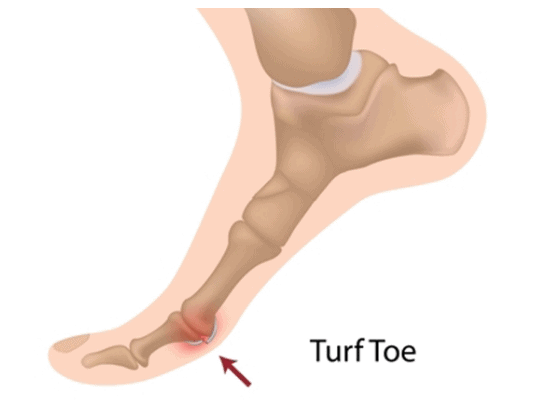Metatarsalgia Exercises
Read More >
Turf Toe originated from using artificial pitches for sports, as these playing surfaces are hard and slippery when wet. During sprinting, the big toe is extended when pushing off; forced hyperextension can cause a sprain of the soft tissues under the big toe joint, hence the name Turf Toe.
The medical term for this injury is a first metatarsophalangeal joint sprain. The capsular structure under the big toe differs from the remaining four. It has a thick articular capsule fused with tendinous, ligamentous, and osseous structures.
The collateral ligaments on the outer aspect of the joint provide stability, but the joint has limited stability due to the shallow joint cavity. The ligamentous structure of the Plantar Plate assists with stability alongside the Flexor Hallicus Brevis.
Hyperextension or pulling upward of the big toe joint can overstretch the tendons and ligaments attaching to the big toe, causing a ligament or capsule sprain.
The common cause of Turf Toe during sport occurs when a foot is fixed to the ground, with the heel elevated, and a player lands on the back of the foot. It is speculated that more modern, lightweight and flexible football boots facilitate increased frequency of first metatarsophalangeal joint sprains.
Mechanisms of turf toe injury are often quick, such as a slip or trip when sprinting or if there is impact to the joint from an instrument such as a hockey stick or front hitting the big toe off a wall.
Repetitive hyperextension can lead to a more gradual onset of Turf Toe through activities such as kneeling, wearing high heels and dancing.
Other causes include Brazilian jiu–jitsu, football and Ballet.
A consultation with a Sports Medicine Doctor, a foot specialist, or a Physical Therapist can help establish a turf toe diagnosis. A careful clinical interview followed by a clinical assessment is sufficient to establish a diagnosis and a grading of the ligament tear.
From that point, a referral may be made for a scan to confirm the diagnosis. An MRI is the most accurate form of scan for diagnosis of Turf Toe, while an ultrasound is a cost-effective alternative.
An x-ray is unable to diagnose Turf Toe.

This is usually overstretching or less than 10% tear of the soft tissue structures around the big toe. Treatment can involve taping, icing, rest, and compression. There may be subtle bruising, and return to play may be immediate with some additional support.
This is the sign of a partial tear of the ligaments or tendons around the joint. The R.I.C.E principle may be applied initially to protect the joint and provide pain relief. Pain levels are often higher than a grade 1 tear, with more visible swelling and bruising. A period of rest and immobilization from sport and exercise may be required.
This is a complete tear or rupture of the surrounding ligaments of the big toe. It is often associated with a dislocation of the big toe. Immediate immobilization is necessary, and surgery may be considered for these cases depending on the individual’s activity levels. With a Grade 3 tear, there may be an avulsion fracture, so imaging such as an MRI is recommended.
In the initial instance, home remedies such as ice, compression, and offloading are beneficial for reducing pain levels and protecting the joint. Turf toe taping using zinc oxide rather than KT Tape may be applied by a Physical Therapist or a splint to protect the joint.
If the injury results from repetitive motion, gait analysis may be required to identify what is causing an overload of the big toe joint. Footwear advice for stability shoes or custom insoles may be required to support the foot and ankle.
A Physical Therapist may prescribe strengthening exercises alongside balance and stability exercises to facilitate optimal foot movement.
Steroid injections are sometimes used to reduce inflammation in the joint. This is not common in a typical clinical setting but may be used in a sporting environment.
Surgery is rare for turf toe and only for Grade 3 injuries. This may stabilize a fracture, correct a deviating big toe, remove a loose body, or preserve the joint from developing arthritis.
Turf Toe Taping aims to provide stability to the big toe joint so it can’t go into hyperextension. This should be done with rigid zinc oxide tape as KT Tape is too stretchy.
Follow the steps below for Turf Toe Taping:
You can run with Turf Toe if you don’t have any pain while running or if the pain doesn’t increase within 24 hours of a run.
If it is painful when walking, running is not a sensible option and one should consider non-impact activities such as the elliptical or swimming.
You can still workout with Turf Toe. For cardiovascular exercise, we recommend the elliptical machine or swimming. Leg strengthening exercises such as deadlifts, squats, and leg press machines are ok once the foot is kept flat throughout the movement.
This article is written by James McCormack, a Foot and Ankle Specialist who is an expert in treating Turf Toe.
This is not medical advice. We recommend a consultation with a medical professional such as James McCormack if you are experiencing any of the symptoms discussed in this article. James offers Online Physiotherapy Appointments weekly and face-to-face appointments in his London clinic.